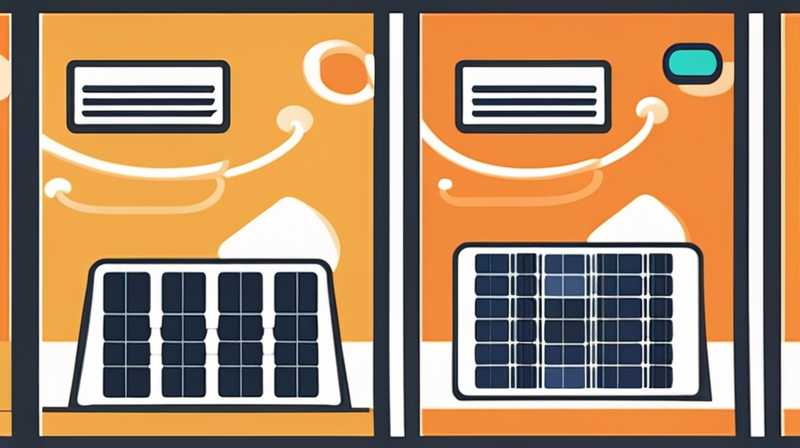
1. Solar panels typically can connect to a load requiring between 100 to 4000 watts of electricity, depending on the panel’s specifications, application, and system design; 2. The ideal solar panel watt rating depends on the energy needs of the users and their location; 3. Understanding the wattage capacity of solar panels helps optimize energy generation for various applications; 4. Various factors must be considered, such as sunlight exposure, panel orientation, and electrical system.
1. UNDERSTANDING SOLAR PANEL WATTS
Solar panels, or photovoltaic (PV) systems, convert sunlight into electricity through the photovoltaic effect. The wattage of these systems is crucial for determining how much power they can produce and, consequently, how many devices or appliances they can support. Power generation capacity is typically indicated on the panel itself, measured in watts. Common residential solar panels usually range from 250 to 400 watts per panel, with high-efficiency options available.
The connection of solar panels to a load involves understanding the entire solar energy system. Size, configuration, and intended use of the solar array play significant roles in how many watts of electricity can reliably be supplied. Owners of solar installations must pay attention to their electrical consumption and how it corresponds to the capabilities of the solar panels.
2. FACTORS AFFECTING WATTAGE CONNECTION
There are several critical parameters to consider when assessing how many watts of light or power a solar panel can connect to.
SOLAR PANEL RATING
The rating of the solar panel is paramount. Manufactured specifically for certain outputs, these panels come in various sizes and wattages adapted for different applications. For instance, a 400-watt panel can produce an estimated 1.6 to 2.5 kWh per day, depending on sunshine hours.
SYSTEM CONFIGURATION
Combined systems, which include battery storage and inverters, greatly influence the efficiency and capacity of energy delivery from solar panels to the load. The inverter converts the direct current (DC) generated by the solar panels into alternating current (AC), which is commonly used in household appliances.
3. LOAD CONSIDERATIONS
Understanding the wattage requirements of appliances and lighting fixtures is crucial for ensuring compatibility.
LIGHTING NEEDS
For instance, an LED bulb typically consumes about 10 to 15 watts. A system capable of connecting to ten such lamps would need to account for a minimum of 100 to 150 watts of solar panel capacity.
APPLIANCE POWER DEMAND
Larger appliances like refrigerators may demand 100 to 800 watts or even more, necessitating a far greater solar array, stretching towards 500 watts or higher per panel system.
4. LOCATION AND SUNLIGHT AVAILABILITY
The geographical positioning of solar panels significantly influences their energy output.
CLIMATE FACTORS
Regions exposed to more sunlight typically yield higher energy production. For instance, panels situated in areas like California or Arizona can generate more watts compared to those placed in cloudy regions such as the Pacific Northwest.
ANGLE AND ORIENTATION
The angle at which solar panels are installed also has a major impact on the total wattage produced. Panels ideally positioned to maximize sunlight exposure throughout the day maximize energy production potential.
5. SYSTEM LIMITATIONS
Despite the capabilities of solar panels, limitations exist.
EQUIPMENT LIMITATIONS
The capacity of additional equipment such as inverters and batteries plays a significant role in how much power can ultimately be used from solar energy. Incorrect sizing can lead to decreased system efficiency or even failure.
REGULATIONS AND CODES
Local codes and regulations may also stipulate the maximum output that can be connected, particularly in residential areas with specific guidelines. It becomes essential to consult with local authorities and energy providers to comprehend any such limitations.
FREQUENTLY ASKED QUESTIONS
WHAT IS THE COMMON WATTAGE RANGE FOR SOLAR PANELS?
Most residential solar panels have wattage outputs ranging from 250 to 400 watts. Higher efficiency models may go as high as 450 watts or more. When selecting panels, individuals must consider the energy requirements of their home, including specific appliances and potential future energy needs.
CAN SOLAR PANELS BE CONNECTED IN SERIES OR PARALLEL?
Yes, solar panels can be connected both in series and parallel to augment total wattage output. Connecting in series increases voltage, while parallel enhances current capacity. The choice depends on the specifics of the power system and the intended energy consumption patterns, crucial for optimizing performance in residential and commercial setups.
HOW DOES SUNLIGHT AFFECT SOLAR PANEL ENERGY OUTPUT?
The amount of energy solar panels produce is intimately tied to the sunlight they receive. Increased sunlight equates to more energy generation, whereas shading from trees or buildings can significantly diminish output. Geographic location and orientation further impact sunlight exposure, necessitating careful planning in installation.
Evaluating solar panel connections involves a complex interplay of energy requirements, system configurations, and environmental factors. Understanding these interdependencies allows users to optimize energy production effectively. Thoughtfully analyzing the load and selecting appropriate solar systems tailored to specific demands ensures efficient energy usage. As demand for renewable energy grows, solar panels serve not just as an alternative power source but as integral components of energy-efficient systems across many sectors. Above all, awareness about energy consumption patterns and environmental conditions is crucial in maximizing solar panel benefits.
Original article by NenPower, If reposted, please credit the source: https://nenpower.com/blog/how-many-watts-of-light-can-a-solar-panel-connect-to/


